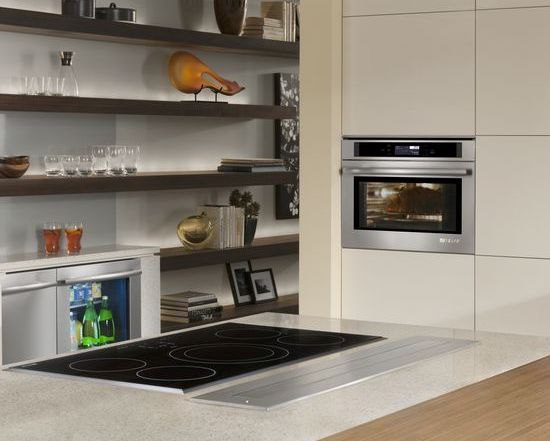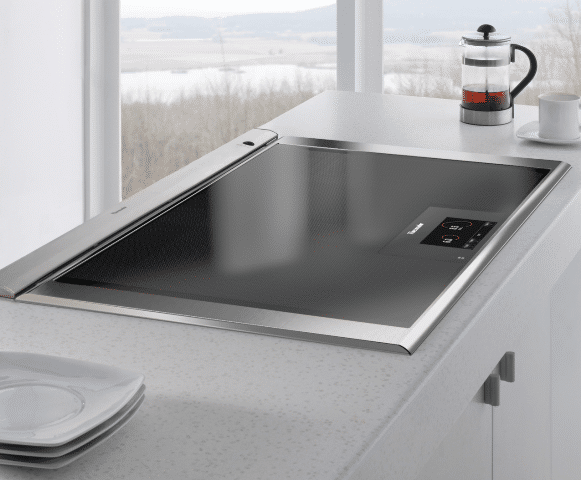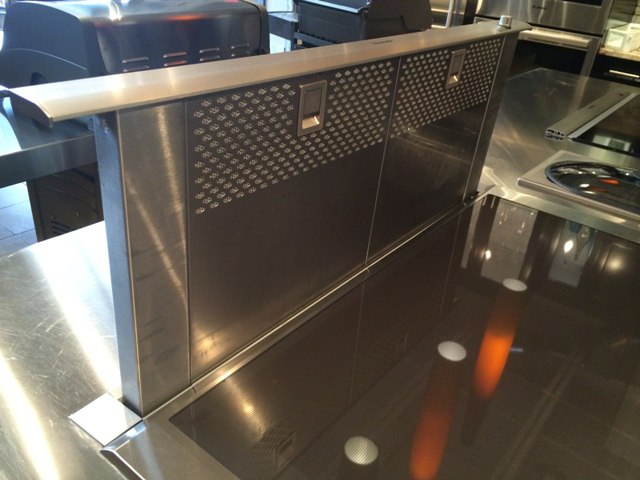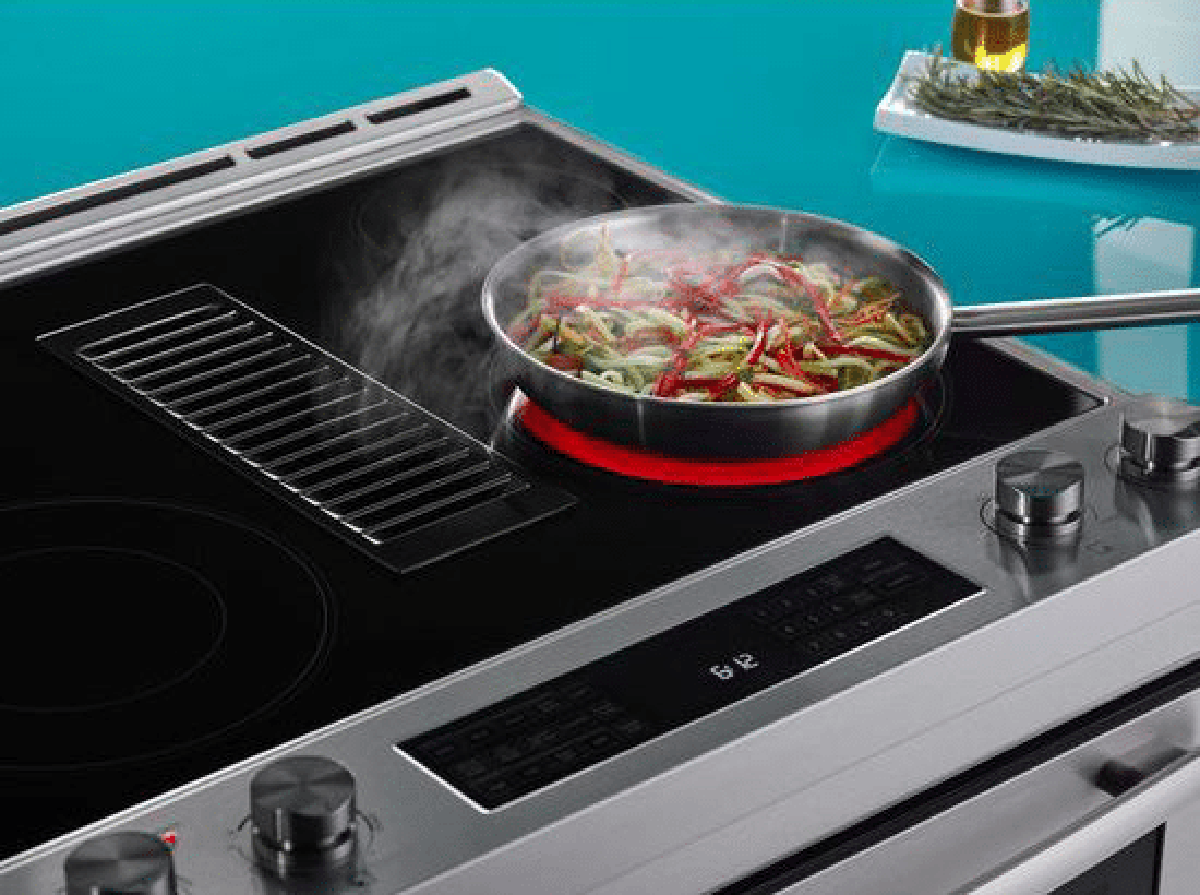I am not a huge fan of downdrafts. If you are buying a gas range, the BTU’s of a new gas range will be at least 30% more powerful than a gas range 10 years ago.
There will be at least one burner with 15,000 BTU's or hotter, which means you need to properly vent your kitchen.
Yet, a downdraft vent has not changed much. Sure, many are taller with better motors, but you are still pushing more heat down a small aperture while reversing gravity. Smoke naturally rises. There is also no capture area to pool smoke in a downdraft like an overhead hood.
However, this ventless option does have limited applications. We will look at Thermador, and the downdraft to see if this is right for your home.
What is a Downdraft?
Thermador Downdrafts
Thermador and Jenn-Air were the American pioneers of downdraft in the 1970’s. Jenn-Air is flush mounted to the counter, while Thermador rises above the cooking surface. Thermador has higher CFM’s and more blower choices than the Jenn-Air downdraft.

Jenn-Air Downdraft

Thermador Downdraft
As overhead hoods became more functional and better looking, downdrafts waned in popularity. They are now predominantly used in islands and as a comparable solution to certain applications.

Features:
- Suitable for wall or island applications
- Downdraft rises over 13" to capture steam from the tallest pots
- Downdraft recirculation possible with module RECIRC36DF
- Three fan speeds
- Dishwasher safe full-face filters also act as a splatter shield
- Filter systems are highly efficient at capturing grease
- Powerfully quiet ventilation systems
- Blowers sold separately
- Choose from Inline, Remote or Integrated Blowers
- Brushed stainless steel finish
- Easy to operate control buttons
- Replacement charcoal filters available
How to Buy
The downdraft is a combination of three different pieces. It is available in 30” or 36”, with the 600 CFM integrated blower and recirculation kit all purchased separately. We have it on display in our Dorchester store. The finished product looks like this:

Should You Buy This?
My knee jerk reaction would be no. However, it is better than no venting system at all. You will be removing smoke and grease with the filters.
The now infamous Make-Up Air laws in Massachusetts are satisfied, because you are not removing any air. You also do not have to run ducts, so the installation is easier.
I see this as a city condo solution. You cannot vent outside in many existing condominiums, because of concrete flooring or restrictions from the condo board or even a historical society (anyone reading from Beacon Hill, Back Bay or Cambridge can understand).
Other than that, I do not know who should buy a ventless downdraft. You would already have the ducts in an existing kitchen, (normally).
You can always plan a hood in new construction. Traditional hood ducting is better, because it removes the stale, greasy air outside your house. (Read: Downdraft vs. Island Hood Ventilation here). Downdrafts can never be as functional or efficient as a traditional hood.
I may not like the ventless downdraft, but it does have its place in certain homes.
Additional Resources
Get the Yale Ventilation Buying Guide with features, specs and a complete how to vent properly in any installation. Well over 110,000 people have read a Yale Guide.

Related Articles
Why Should You Trust Us?
It seems that every appliance review has nothing but glowing comments about almost every product, yet you read customer reviews and they are almost universally bad.
We are here to fill in the disconnect. We'll give you the best features, and the drawbacks as well, including reliability based on over 37,000 calls performed by our service team just last year. Our goal is to give you ALL the information so you know what's right for you.
Please consider subscribing or adding to the conversation in the comments below. We appreciate you stopping by.
Steve Sheinkopf
Steve Sheinkopf is the third-generation CEO of Yale Appliance and a lifelong Bostonian. He has over 38 years of experience in the appliance industry, and he is a trusted source of information for consumers on how to buy and repair appliances.
Steve has also been featured in numerous publications, including the
New York Times,
Consumer Reports,
The Boston Globe,
Bloomberg Radio, the
New York Post,
The Wall Street Journal, and
Entrepreneur, for his knowledge of how to buy appliances and appliance repair.
Steve is passionate about helping consumers find the best appliances for their needs, and he is always happy to answer questions and provide advice. He is a valuable resource for consumers who are looking for information on appliance buying, repair, and maintenance.
Despite being the worst goalie in history, Steve is a fan of the Bruins and college hockey, loves to read, and is a Peloton biker. The love of his life is his daughter, Sophie.






